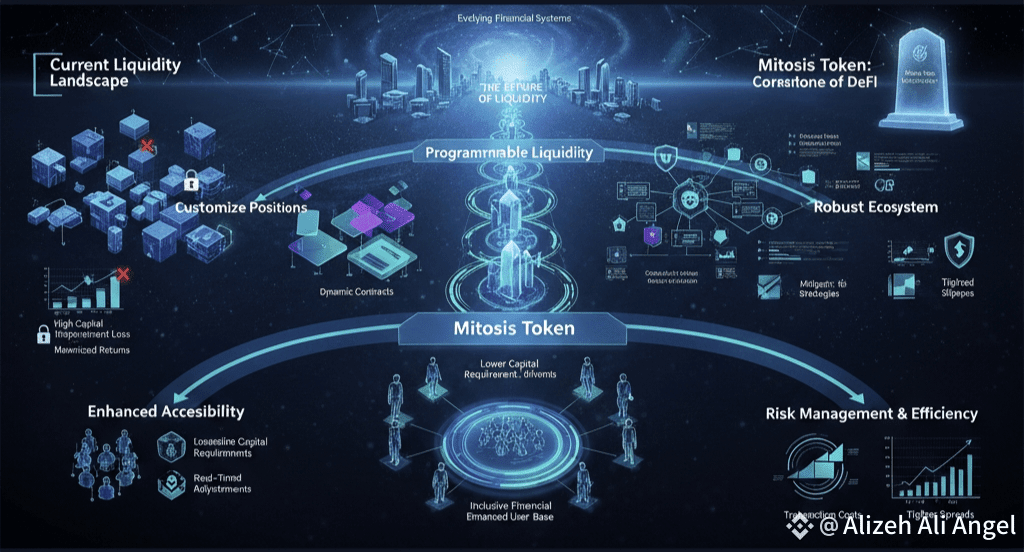@Mitosis Official | #Mitosis | $MITO
The decentralized finance (DeFi) ecosystem is at the forefront of innovation, continuously evolving to meet the diverse needs of its users. Central to this transformation is Mitosis Token, a project designed to revolutionize the way liquidity is provided in decentralized markets. By introducing the concept of programmable liquidity, Mitosis Token not only enhances user experience but also opens new avenues for financial engineering. This article explores how Mitosis Token is reshaping the liquidity landscape and its implications for the future of DeFi.
Understanding the Current Liquidity Landscape:
Liquidity is vital for the smooth operation of any financial market. It enables assets to be bought and sold quickly, ensuring efficient pricing and transaction execution. In DeFi, liquidity allows traders to enter and exit positions with ease, which is especially crucial in volatile markets. However, traditional liquidity pools come with significant limitations, such as high capital requirements, risks of impermanent loss, and inefficiencies related to centralized data sources.
Mitosis Token targets these concerns by offering a more flexible and user-friendly approach to liquidity management. Built on advanced financial engineering principles, Mitosis is positioned to enhance both accessibility and efficiency within the DeFi space.
The Concept of Programmable Liquidity:
A standout feature of Mitosis Token is its ability to transform conventional liquidity positions into programmable components. This innovation allows liquidity providers to customize their positions based on their individual strategies and market conditions. Instead of committing assets to a fixed pool, users can create dynamic liquidity contracts that can adjust in real-time.
For example, a liquidity provider might opt to allocate liquidity to specific trading pairs only when certain price thresholds are reached. Alternatively, they may choose to adapt their exposure in response to market volatility. Such customization not only empowers users to manage risks more effectively but also maximizes potential returns. Consequently, Mitosis Token fosters a more adaptable liquidity model that can reshape itself alongside the ever-changing market dynamics.
Enhancing Accessibility for Traders:
A primary objective of Mitosis Token is to democratize access to liquidity within the DeFi ecosystem. Traditional liquidity pools often require significant upfront investment, thus excluding smaller investors. Mitosis Token changes this narrative by enabling participation with lower capital requirements.
With Mitosis, even those with modest amounts to invest can engage in liquidity provisioning on their terms. By lowering the barriers to entry, Mitosis Token helps broaden the user base in the DeFi sector, allowing a more diverse group of individuals to benefit from the liquidity ecosystem. This approach fosters a more inclusive financial environment.
Risk Management and Efficiency:
Effective risk management is crucial in the world of trading, and Mitosis Token significantly enhances liquidity providers’ abilities to mitigate risks. By permitting programmable liquidity, users can implement protective strategies that shield their investments from adverse market movements.
For instance, liquidity providers can define specific triggers for when to engage or disengage their liquidity, effectively minimizing exposure during high-volatility periods. This proactive approach results in better resource allocation, as liquidity can be adjusted based on real-time market data.
Moreover, the efficiency gained through programmable liquidity can reduce transaction costs. When liquidity is employed intelligently, traders can benefit from tighter spreads and decreased slippage, resulting in a more favorable trading experience.
Building a Robust Ecosystem:
Mitosis Token is not just a tool for individual traders; it aims to foster a comprehensive ecosystem that benefits all participants. By attracting a wide range of liquidity providers—from retail investors to institutional players—Mitosis contributes to a more liquid marketplace. This heightened liquidity not only enhances general market health but also improves price discovery and market stability.
Additionally, integrating Mitosis Token into existing DeFi platforms can stimulate collaboration and innovation, leading to the creation of new financial products and services. As more projects embrace the principles of programmable liquidity, the foundation for enhanced and efficient financial systems will be laid.
The Future of Mitosis Token in DeFi:
As the DeFi sector matures, the need for innovative liquidity solutions will only grow. Mitosis Token is ideally positioned to fulfill this demand due to its focus on programmability, accessibility, and risk management.
In the coming years, the incorporation of Mitosis Token into a variety of DeFi applications could prompt a fundamental shift in how liquidity is managed and perceived. As traders and investors recognize the advantages of programmable liquidity, Mitosis Token stands to become a cornerstone of the DeFi ecosystem.
Conclusion:
Mitosis Token signifies a significant advancement in the landscape of decentralized finance. By transforming liquidity provisioning and cultivating a more flexible, inclusive framework, Mitosis sets the stage for a fresh era of trading and investing.
As the future of DeFi unfolds, Mitosis Token will illuminate the path toward innovative interactions with liquidity. With its emphasis on accessibility, customization, and risk management, Mitosis Token is not simply a passing trend; it is a transformative force poised to enhance the decentralized finance landscape for the better.
As financial systems continue to evolve toward decentralization, Mitosis Token’s role in optimizing liquidity and empowering users will undoubtedly contribute to shaping the next chapter of DeFi.


